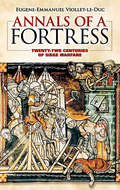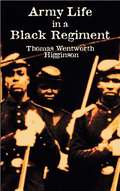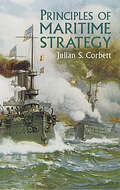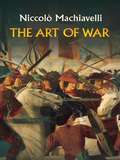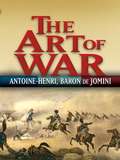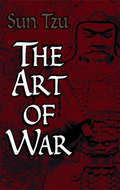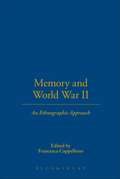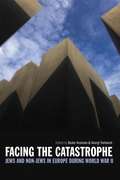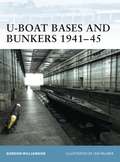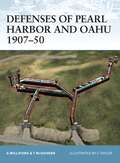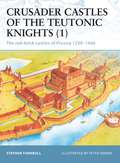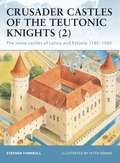- Table View
- List View
Annals of a Fortress: Twenty-two Centuries of Siege Warfare
by Eugene-Emmanuel Viollet-le-Duc Benjamin BucknallCombining the excitement of a novel with the authenticity of a historical document, this gripping book chronicles a castle's rise from obscurity to international attention during the nineteenth century. It profiles a fictional fortress, La Roche-Pont, for an unusual survey of the evolving art of siege warfare--from Gallic tribes attempting to hold off the might of the Roman empire through medieval feuds, protracted religious conflicts of the seventeenth century, and the Napoleonic and Franco-Prussian Wars.The noted architect Eugene-Emmanuel Viollet-le-Duc (1814-1879) was in a unique position to write this book. A central figure in France's Gothic Revival, Viollet-le-Duc had a second career in the military that included a prominent role in the defense of Paris during the Franco-Prussian War of the 1870s. With this accessible, well-researched study, he exerted an enduring influence on French military defensive thinking. Subtle and enchanting in its blend of fact and fiction, Annals of a Fortress continues to offer a brilliant evocation of more than 2,000 years of European warfare.
Army Life in a Black Regiment (Civil War)
by Thomas Wentworth Higginson"Army Life in a Black Regiment has some claim to be the best written narrative to come from the Union [side] during the Civil War. Higginson's picture of the battle which was the origin of "praise the Lord and pass the ammunition" and his reading of the Emancipation Proclamation to the black regiment are unsurpassed for eloquence." — historian Henry Steele CommagerOriginally a series of essays, this important volume was written by a Union colonel from New England, in charge of African-American troops training on the Sea Islands off the coast of the Carolinas. A lively and detailed wartime diary, the book offers a refreshing portrait of life in the Union Army from an officer's point of view, recording opinions of other commanders and capturing the raw humor that develops among the men in combat. Higginson's descriptions of the soldiers, routines of camp life, and southern landscapes are unforgettable, as is the account of his near escape from a cannon ball. An unusual historical document intended to introduce new generations of readers to an American past that should not be forgotten, Army Life in a Black Regiment will be invaluable to students of Black History and the American Civil War.
Principles of Maritime Strategy
by Julian S. CorbettThis brilliant exposition established British naval historian Julian Corbett (1854–1922) as one of the great maritime strategists. Corbett placed naval warfare within the larger framework of human conflict, proposing that the key to maritime dominance lies in effective use of sea lines for communications and in denying that use to the enemy. His concept — which regarded naval strategy not as an end in itself but as a means to an end, with that end defined by national strategy — makes this a work of enduring value.Principles of Maritime Strategy emphasizes precise definitions of terminology and ideas as the antidote to loose and purposeless discussion and the direct path to the fundamental data on which all are agreed. As Corbett notes in the Introduction, "In this way we prepare the apparatus of practical discussion; we secure the means of arranging the factors in manageable shape, and of deducing from them with precision and rapidity a practical course of action. Without such apparatus no two men can even think on the same line; much less can they ever hope to detach the real point of difference that divides them and isolate it for quiet solution."Much quoted and referenced, this ever-relevant work is an indispensable resource for military professionals, historians, and students.
The Illustrated Art of War
by Sun TzuGraced with color illustrations of Asian art treasures, this gift edition of the world's earliest and most prestigious military treatise covers principles of strategy, tactics, maneuvers, and other ever-relevant topics. Required reading in many military institutions, its ancient wisdom offers many modern applications to business, law, and sports.
The Art of War
by Henry Neville Niccolò MachiavelliFlorentine statesman, writer, and political theorist, Niccolò Machiavelli (1469-1527) considered The Art of War his most important work. Five centuries later, after serving as a guide to Frederick the Great, Napoleon, and countless other military leaders, it remains an authoritative treatise on the fundamentals of warfare.Best known as the political theorist who wrote The Prince, Machiavelli used this book to advocate strategies for Italy's increased military prowess and political strength. Machiavelli was the first to propose a global context for the functional unity of war and politics, with the former serving as an instrument of the latter. Written in the form of dialogues, this 1520 work represents a humanistic treatment rather than a textbook approach. It clearly states and discusses the fundamentals of military organization and strategy: handling recruitment and weapons, motivating troops, demoralizing enemies, and achieving tactical and strategic advantages. Essential to the education of students of military history, strategy, and theory, The Art of War continues to inspire readers.
The Art of War
by W. P. Craighill Antoine-Henri Jomini G. H. MendellAn eyewitness to most of the important battles of the Napoleonic Wars, Baron Antoine Henri de Jomini served with both the French and the Anglo-Allied armies. His firsthand accounts of the conflicts are the most authoritative ever written, hailed by experts as both accurate and insightful. It endures as the definitive work on strategy and tactics and as a fundamental source of modern military thought. In fact, generals on both sides of the American Civil War were well schooled in The Art of War. Jomini approaches warfare from several directions, including strategy, tactics, logistics, engineering, and diplomacy. He examines each in turn, and he offers an analysis of strategic problems posed by a variety of theaters and terrains, the tactics of attack and defense, surprise maneuvers, special operations, the importance of reconnaissance, and the deployment of forces.Few can match the breadth of advice offered by the man who was critical to the success of both Napoleon and Czar Alexander I. Unsurpassed in its influence on military thinking, doctrine, and vocabulary, Jomini's classic remains both a historic and practical guide to students of warfare.
Principles of War
by Carl Von ClausewitzWritten two centuries ago by a Prussian military thinker, this is the most frequently cited, the most controversial, and in many ways, the most modern book on warfare. In this work, Clausewitz examines moral and psychological aspects of warfare, stressing the necessity of courage, audacity, and self-sacrifice, as well as the importance of public opinion.
The Art of War
by Sun TzuPreserved in China for more than 2,000 years before it was brought to the West by the French, this compact little book is widely regarded as the oldest military treatise in the world. Rumored to have been used by Napoleon in his campaigns to conquer Europe, it today retains much of its original merit. American officers read it closely during World War II. The Japanese army studied the work for decades, and many 20th-century Chinese officers are said to have known the book by heart. More recently, it has also been viewed as a valuable guide to competing successfully in business.Stressing the importance of attacking your enemy when he is unprepared and scheming to discover his plans, the author advises avoiding the strong and striking at the weak, and using spies for every kind of business. Principles of strategy, tactics, maneuvering, and communications, the treatment of soldiers, the importance of strong troops and well-trained officers, and the administration of rewards and punishments all have a modern ring to them.A valuable guide to the conduct of war, this classic of military strategy is indispensable to military personnel, history enthusiasts, and anyone intrigued by competition and rivalry.
Memory and World War II: An Ethnographic Approach
by Francesca CappellettoForeword by Michael LambekThe death and destruction of war leave behind scars and fears that can last for generations. This book considers the connections between memory and violence in the wake of World War II.Covering the range of European experiences from East to West, Memory and World War II takes a long-term approach to the study of trauma at the local level. It challenges the notion of collective memory and calls for an understanding of memory as a fine line between the individual and society, the private and the public. International contributors from a range of disciplines seek new ways to incorporate local memory within national history and consider whether memories of extreme violence can be socially transformed. Personal testimony reveals the myriad ways in which communities react to and reconstruct the horrors of war. What we learn is that terrifying experiences reside not only in memories of the past but remain embedded in present-day lives.
Open Fire: Understanding Global Gun Cultures
by Charles SpringwoodGuns are everywhere: three quarters of a billion guns - from pistols to machine guns - exist in the world today. And guns are everything: a hard-won symbol of individual freedom, an index of crime and disorder, a whole industry legitimately contributing to an economy, a popular piece of sports equipment, and an object of desire, endlessly duplicated by toys, video games and films. Open Fire presents a broad analysis of the social, cultural and political significance of firearms and the worlds they create. Illustrated with a wide range of case material - from North and South America, Europe, Asia and Africa - Open Fire explores and questions this global icon of our times. Why do guns proliferate? What does it mean to shoot or to be shot? Who owns guns and who does not? How is a firearm, a manufactured thing, very different from any other object? Is there such a thing as a "gun psychology"? How are firearms regarded in places where they are largely non-existent? Is a gun a different thing when held by a white man?
War Experiences in Rural Germany: 1914-1923 (The Legacy of the Great War)
by Benjamin ZiemannWorld War I was a uniquely devastating total war that surpassed all previous conflicts for its destruction. But what was the reality like on the ground, for both the soldiers on the front-lines and the women on the homefront? Drawing on intimate firsthand accounts in diaries and letters, 'War Experiences in Rural Germany' examines this question in detail and challenges some strongly held assumptions about the Great War. The author makes the controversial case for the blurring of 'front' and 'homefront'. He shows that through the constant exchange of letters and frequent furloughs, rural soldiers maintained a high degree of contact with their home lives. In addition, the author provides a more nuanced interpretation of the alleged brutalizing effect of the war experience, suggesting that it was by far not as complete as has been previously understood. This pathbreaking book paints a vivid picture of the dynamics of total war on rural communities, from the calling up of troops to the reintegration of veterans into society.
Facing the Catastrophe: Jews and Non-Jews in Europe during World War II (Occupation in Europe)
by Beate Kosmala Georgi VerbeeckCovering Western and Eastern Europe, this book looks at the Holocaust on the local level. It compares and contrasts the behaviour and attitude of neighbours in the face of the Holocaust. Topics covered include deportation programmes, relations between Jews and Gentiles, violence against Jews, perceptions of Jewish persecution, and reports of the Holocaust in the Jewish and non-Jewish press.
Japanese Pacific Island Defenses 1941–45 (Fortress #1)
by Gordon L. Rottman Ian PalmerThe prolonged and bloody fighting for control of the Japanese occupied Pacific islands in World War II is a key point in 20th-century warfare. No two islands were alike in the systems and nature of their defensive emplacements, and local improvization and command preferences affected both materials used and defensive models. This title details the establishment, construction and effectiveness of Japanese temporary and semi-permanent crew-served weapons positions and individual and small-unit fighting positions. Integrated obstacles and minefields, camouflage and the changing defensive principles are also covered.
U-Boat Bases and Bunkers 1941–45 (Fortress)
by Ian Palmer Gordon WilliamsonFew of the massive military structures built by Germany during World War II are as impressive as the U-Boat bases and bunkers in Germany, Norway and France. This title takes a close look at the formidable edifices on the French coast (Brest, Lorient, St Nazaire, La Pallice, Bordeaux) in Norway (Bergen, Trondheim) and Germany (Keil, Hamburg, Helgoland) and also focuses on the huge 'Valentin' factory complex at Bremen, which manufactured the new type XXI electro-boats. Bunker protective systems, such as camouflage, light and heavy flak installations and nearby air cover, are also examined as well as resident flotillas and the fate of the bases at war's end.
Japanese Castles 1540–1640 (Fortress)
by Peter Dennis Stephen TurnbullThe landscape of 16thand 17th-century Japan was dominated by the graceful and imposing castles constructed by the powerful 'daimyo' of the period. In this the most turbulent era in Japanese history, these militarily sophisticated structures provided strongholds for the consolidation and control of territory, and inevitably they became the focus for many of the great sieges of Japanese history: Nagashino (1575), Kitanosho (1583), Odawara (1590), Fushimi (1600), Osaka (1615) and Hara (1638), the last of the battles that brought an end to a period of intense civil war. This title traces their development from the earliest timber stockades to the immense structures that dominated the great centres of Osaka and Edo.
American Civil War Fortifications: Coastal Brick and Stone Forts (Fortress #6)
by Angus Konstam Donato SpedaliereThe 50 years before the American Civil War saw a boom in the construction of coastal forts in the United States of America. These stone and brick forts stretched from New England to the Florida Keys, and as far as the Mississippi River. At the start of the war some were located in the secessionist states, and many fell into Confederate hands. Although a handful of key sites stayed in Union hands throughout the war, the remainder had to be won back through bombardment or assault. This book examines the design, construction and operational history of those fortifications, such as Fort Sumter, Fort Morgan and Fort Pulaski, which played a crucial part in the course of the Civil War.
The Lines of Torres Vedras 1809–11 (Fortress)
by Bill Younghusband Ian FletcherFollowing the battle of Bussaco on 27 September 1810 Wellington's heavily outnumbered troops began to withdraw towards Lisbon. By the evening of 9 October the British and Portuguese began to withdraw behind a line of defensive works that had been built to the north of Lisbon. These were not the rudimentary field works that the French anticipated, but an enormous network of forts, batteries and redoubts whose construction had been started the previous November the Lines of Torres Vedras. This 30-mile-wide line utilised the area's natural defences, damming rivers, scarping hillsides, blocking roads and establishing forts upon almost all of the hills. This title describes its design, creation and effectiveness in the face of French attacks.
Defenses of Pearl Harbor and Oahu 1907–50 (Fortress)
by Chris Taylor Glen Williford John Richards Terrance McGovernAt the beginning of the 20th century, the military importance of the Hawaiian Islands became clear. Oahu in particular was a key bastion in projecting America's military power in the Pacific. The island was turned into a military fortress and yet it also became the site of one of America's greatest defensive failures, the Japanese attack of December 7, 1941. By the end of World War II, the harbor itself was the most heavily defended in the world, and the island had earned the sobriquet "Fortress Oahu". This title documents the development of the coastal, air and land defense systems that served to protect Pearl Harbor and Honolulu from 1907 to 1950, and seeks to understand why these failed at a critical point.
English Civil War Fortifications 1642–51 (Fortress)
by Peter Harrington Donato SpedaliereThe techniques of European warfare were transformed during the 15th and 16th centuries by the use of gunpowder and by substantial progress in the effectiveness and destructive power of artillery. The series of conflicts in the 1640s, known collectively as the English Civil War, was the first in the British Isles that reflected this new reality. Sieges that aimed at isolating and reducing fortified places became the dominant instrument for prosecuting the war and protective fortifications were vital, for both the besieged as well as the besieger. This title describes how both the Parliamentarians and the Royalists made use of new fortification techniques throughout the course of this conflict.
Crusader Castles of the Teutonic Knights: The red-brick castles of Prussia 1230–1466 (Fortress)
by Peter Dennis Stephen TurnbullThroughout their stormy history the Teutonic Knights of Germany have always been the most controversial brotherhood ever to call themselves 'Knights of Christ'.They were the most warlike of the religious orders, and this is reflected in the architecture they left behind. In contrast to the Templars who are remembered for their churches, the Teutonic memorials are the magnificent brick-built castles they built as a result of their conquest of Prussia between 1230 and 1380. Many of these dramatic fortresses still exist today in what is now Poland and provide a unique example of an architectural style that closely reflects the nature of the Order.
Fortresses of the Peninsular War 1808–14 (Fortress)
by Chris Taylor Ian FletcherIn the course of the Peninsular War, Wellington's army fought several hard battles and smaller actions, but it was the bloody sieges that troubled him more than anything else. Indeed, the performance of his army during the sieges was probably the most disappointing aspect of what was otherwise an extremely successful campaign. Taking 1808 as its starting point, this title deals with the fortress sieges that involved Wellington's Anglo?Portuguese army, and concentrates on four key sites in particular (Ciudad Rodrigo, Badajoz, Burgos and San Sebastián). All of these played a vital role in the war due to their strategically important positions. It documents both the sieges and the storming of the fortresses, as well as the general role of the fortresses in Spain and the impact they had on the thinking of the commanders and strategies of the armies involved.
Fortifications in Wessex c. 800–1066 (Fortress)
by Donato Spedaliere Ryan LavelleThe defence of the 9th-century kingdom of Wessex under King Alfred against the 'Great Viking Army' is one of the major military achievements of Early Medieval history. While the guerrilla warfare in the Somerset marshes and the battle of Edington are characteristic of Alfred's military abilities, his definitive physical achievement was a series of some 30 well-structured fortifications (known as burhs) across the kingdom. Many of these fortifications survive to this day and some were even reinforced to stand up to German tanks in the expected invasion of 1940. This title describes their beginnings in the turbulent early years of Alfred's reign as well as their subsequent development and use.
The Fortifications of Malta 1530–1945 (Fortress)
by Steve Noon Charles StephensonThe Island of Malta occupies a pivotal position in the Mediterranean, forming an outpost between North Africa and the soft underbelly of Europe. Such has been its strategic importance throughout the years that it has become one of the most fortified places in the world. Following the successful defence of the island during the Great Siege of 1565, the Knights Hospitaller built new walls and fortifications. These defences failed when Napoleon occupied Malta in 1798, and the island was retaken by the British in 1800. From this point onwards, Malta's defences were modernised throughout the 19th century and the island's final test came during World War II. This book examines all these different styles of fortification from the 16th to the 20th century.
Crusader Castles of the Teutonic Knights: The stone castles of Latvia and Estonia 1185–1560 (Fortress #19)
by Peter Dennis Stephen TurnbullThe original forced conversion of pagan Livonia, what is now the Baltic states of Latvia and Estonia, was carried out by a military order known as the Brethren of the Sword. In 1236 this order was incorporated into the Teutonic Knights following a catastrophic military defeat. The knights had always consolidated their conquests through networks of castles and fortified places, and the Livonian Chapter of the Teutonic Order built castles of stone. This title covers the developmental and operational history of these fortresses over the length of the Middle Ages. It details how the Baltic fortifications of the Teutonic Knights evolved to reflect the changing nature of siege warfare and the increasing dominance of gunpowder in warfare.
Fortifications of the Western Front 1914–18 (Fortress)
by Peter Dennis Paddy GriffithFollowing the early battles of 1914 along the Marne and in the Ypres salient, World War I rapidly changed from a war of movement into one of attrition, with the opposing sides entrenching themselves in a line of fortified positions from the Flanders coastline to the Swiss border. This volume details the different styles of fortification used on the Western Front throughout the course of the war, from the early ditches of 1914 to the complicated systems of 1918. It explains the development of the 'defence in depth' German system and the British reaction to it, as well as illustrating the importance of the pre-war forts, particularly around Verdun.
